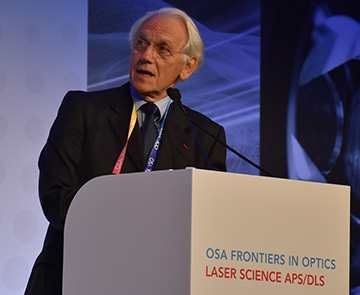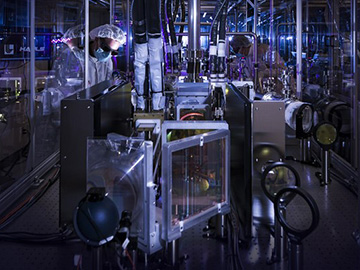
Gerard Mourou at FiO+LS 2018.
On Tuesday, in the second of two plenary addresses at the Frontiers in Optics/Laser Science meeting in Washington, D.C., Gerard Mourou of the École Polytechnique in France described how ultrafast, high-intensity lasers—enabled by the development of chirped-pulse amplification in the 1980s by Mourou and Donna Strickland—are setting up exotic new science in the coming decades of the 21st century.
From the atomic to the subatomic
Mourou noted that the lasers he was describing are the ones operating on the petawatt scale, and that form the foundation of recent projects like the European Extreme Light Infrastructure (ELI). A petawatt laser, he said, provides power levels “a thousand times greater than all the power stations in the world, but of course only for a very short time,” amounting to tens of femtoseconds.
The availability of these lasers, Mourou continued, offers the prospect of taking laser-enabled science out of the atomic realm, and into the subatomic and nuclear realms. Indeed, he noted the remarkable fact that the 1-eV photons from lasers can be used both to cool ensembles of atoms to the lowest temperatures imaginable, through the laser-cooling techniques that led to or enabled several Nobel Prizes; and to accelerate particles to relativistic velocities and energies on the order of GeV to TeV.
These latter capabilities, coming out of the advent of ultrafast, high-power lasers, are making laser technology a new player in scientific areas such as nuclear physics, cosmology, nonlinear quantum electrodynamics and general relativity, according to Mourou.
Toward “relativistic optics”
The ability to reach these powers traces to CPA, the technique devised by Mourou and Strickland in 1985 to vastly increase the power delivered in ultrashort laser pulses. The now-standard technique involves first stretching a very-low-intensity pulse, then using amplifiers to boost the stretched pulse’s total power, and finally compressing it again to create extremely amplified, very short pulse. The technique has since been improved, Mourou noted, through the development of optical parametric CPAs and the addition of Ti:sapphire lasers to the mix.
These are the basic technologies that have moved lasers from their historical intensity plateau of less than 1015 W/cm2 between 1960 and 1985, to intensities many orders of magnitudes higher since then—and that, Mourou said, have moved the community into the new regime of “relativistic optics.” It offers the potential, he maintained, for accelerating not just electrons to relativistic velocities, but ions and protons as well. And that, in turn, holds out the prospect of extremely compact particle accelerators.
As powers approach the neighborhood of 1029 W/cm2, giving rise to energies at the TeV level, Mourou said, the laser field even starts to modify the vacuum itself—to the mind-bending point where “we can break the vacuum down into elementary particles.”

The High-repetition-rate Advanced Petawatt Laser System (HAPLS) was built by Lawrence Livermore National Laboratory for the Extreme Light Infrastructure facility in the Czech Republic. [Courtesy of LLNL]
The realm of the zeptosecond
The world is already well on the way to power at these levels, with some 15 labs working in the petawatt regime—including the three emerging ELI facilities in Hungary, the Czech Republic and Romania. But to get to still higher intensities by boosting the raw power of the laser, Mourou said, “you need to build systems that are much bigger than the ELI.”
There’s another way to increase pulse power, of course: further shorten the pulse—an area on which Mourou and his colleagues are actively working. “We are already short—10 to 20 femtoseconds—so the pulses are composed of only a few optical cycles,” he said. “But we’d like to go way below that.”
Mourou’s current target is single-cycle pulses on the width scale of zeptoseconds—10–21 second, or a trillionth of a nanosecond. He and colleagues are working on approaches to generate such pulses through new techniques of “relativistic compression” using thin films.
CERN on a dime
Such pulses, he pointed out, can act as a source of 1-MeV coherent gamma rays, and raise the possibility of doing “giant laser acceleration,” to TeV/cm, in solids. The availability of such pulses, he added, also offers the prospect of radically shrinking particle accelerators, moving from the 27-km diameter of the Large Hadron Collider to accelerators with length scales literally in centimeters—“CERN on a dime.”
In the shorter term, Mourou stressed a variety of applications in materials science, nuclear physics, astrophysics and other areas of fundamental science—as well as some societally beneficial uses. On the scientific side, for example, he noted that today’s most powerful lasers offer the ability to simulate black holes on Earth, to inquire whether, and why, they destroy information.
And, for society at large, the ability to drive compact particle-acceleration schemes could improve the availability and targeting of proton therapy and other forms of therapy and bioimaging. There’s even the potential, Mourou said, of addressing the problem of nuclear-power-plant waste by transmutation—changing the half-life of the nuclear material by changing the nuclei of the atoms that constitute it. “In laser high-field science,” Mourou concluded, “I think the best is really yet to come.”
